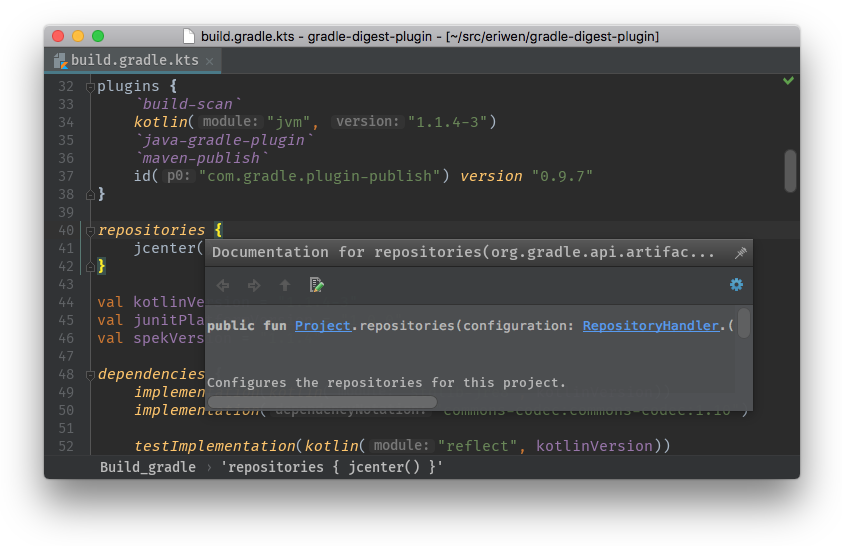Maven Dependency Declare Again With Different Scope
Gradle vs Maven Comparison
The following is a summary of the major differences between Gradle and Apache Maven: flexibility, functioning, user feel, and dependency management. It is non meant to be exhaustive, merely you can check the Gradle feature list and Gradle vs Maven functioning comparison to larn more.

Google chose Gradle as the official build tool for Android; not because build scripts are code, but because Gradle is modeled in a way that is extensible in the most cardinal ways. Gradle's model also allows it to be used for native development with C/C++ and can be expanded to comprehend any ecosystem. For instance, Gradle is designed with embedding in heed using its Tooling API.
Both Gradle and Maven provide convention over configuration. However, Maven provides a very rigid model that makes customization wearisome and sometimes impossible. While this can arrive easier to empathise any given Maven build, every bit long every bit you don't have any special requirements, it likewise makes it unsuitable for many automation issues. Gradle, on the other hand, is built with an empowered and responsible user in heed.
Improving build time is one of the almost direct ways to ship faster. Both Gradle and Maven utilise some form of parallel projection building and parallel dependency resolution. The biggest differences are Gradle'south mechanisms for piece of work avoidance and incrementality. The top 3 features that make Gradle much faster than Maven are:
- Incrementality — Gradle avoids work by tracking input and output of tasks and only running what is necessary, and only processing files that changed when possible.
- Build Cache — Reuses the build outputs of whatever other Gradle build with the aforementioned inputs, including between machines.
- Gradle Daemon — A long-lived procedure that keeps build information "hot" in memory.
These and more than functioning features make Gradle at least twice every bit fast for nearly every scenario (100x faster for large builds using the build cache) in this Gradle vs Maven operation comparison.
Note: Both Gradle and Maven users can take reward of the Build Cache technology available in Gradle Enterprise. Gradle users typically experience an boosted build time reduction of ~50%, while Maven users oft experience reductions of ~xc%. Watch this video to learn more than well-nigh the Gradle Enterprise Maven Build Cache engineering and business instance.

Maven's longer tenure means that its support through IDEs is ameliorate for many users. Gradle'southward IDE support continues to improve chop-chop, notwithstanding. For instance, Gradle now has a Kotlin-based DSL that provides a much amend IDE experience. The Gradle team is working with IDE-makers to make editing support much ameliorate — stay tuned for updates.
Although IDEs are important, a big number of users prefer to execute build operations through a control-line interface. Gradle provides a mod CLI that has discoverability features like `gradle tasks`, as well equally improved logging and command-line completion.
Finally, Gradle provides an interactive spider web-based UI for debugging and optimizing builds: Build Browse™. These tin too exist hosted on-premise to permit an organization to collect build history and do tendency assay, compare builds for debugging, or optimize build times.

Both build systems provide built-in adequacy to resolve dependencies from configurable repositories. Both are able to cache dependencies locally and download them in parallel.
As a library consumer, Maven allows ane to override a dependency, but but past version. Gradle provides customizable dependency selection and substitution rules that can be declared once and handle unwanted dependencies project-wide. This substitution machinery enables Gradle to build multiple source projects together to create blended builds.
Maven has few, built-in dependency scopes, which forces awkward module architectures in common scenarios like using test fixtures or code generation. In that location is no separation between unit and integration tests, for example. Gradle allows custom dependency scopes, which provides improve-modeled and faster builds.
Maven dependency conflict resolution works with a shortest path, which is impacted by declaration ordering. Gradle does full conflict resolution, selecting the highest version of a dependency establish in the graph. In add-on, with Gradle you tin can declare versions as strictly which allows them to have precedence over transitive versions, allowing to downgrade a dependency.
As a library producer, Gradle allows producers to declare `api` and `implementation` dependencies to preclude unwanted libraries from leaking into the classpaths of consumers. Maven allows publishers to provide metadata through optional dependencies, but as documentation only. Gradle fully supports feature variants and optional dependencies.
Nosotros recommend you look more in-depth at Gradle'south features or start with these resource.
Source: https://gradle.org/maven-vs-gradle/
0 Response to "Maven Dependency Declare Again With Different Scope"
Post a Comment